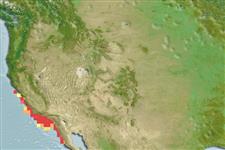Environment: milieu / climate zone / distribuzione batimetrica / distribution range
Ecologia
marino demersale; distribuzione batimetrica ? - 365 m (Ref. 36715), usually 75 - 150 m (Ref. 36715). Subtropical; 38°N - 29°N, 124°W - 115°W
Eastern Pacific: San Francisco in California, USA to northern Baja California, Mexico; rare north of Santa Barbara, California.
Length at first maturity / Size / Peso / Age
Maturità: Lm 28.0 range ? - ? cm
Max length : 56.0 cm TL maschio/sesso non determinato; (Ref. 2850); peso massimo pubblicato: 950.00 g (Ref. 40637); Età massima riportata: 37 anni (Ref. 39277)
Short description
Chiavi di identificazione | Morfologia | Morfometria
Spine dorsali (totale) : 13; Raggi dorsali molli (totale) : 13 - 16; Spine anali: 3; Raggi anali molli: 7 - 8; Vertebre: 27. Branchiostegal rays: 7 (Ref. 36715).
Body shape (shape guide): fusiform / normal.
Adults are found commonly on deep rocky areas in southern California, USA from 30-366 m. Viviparous, with planktonic larvae (Ref. 36715).
Eschmeyer, W.N., E.S. Herald and H. Hammann, 1983. A field guide to Pacific coast fishes of North America. Boston (MA, USA): Houghton Mifflin Company. xii+336 p. (Ref. 2850)
IUCN Red List Status (Ref. 130435: Version 2025-1)
Threat to humans
Harmless
Human uses
Pesca: commerciale; Pesce da pesca sportiva: si
Strumenti
Special reports
Download XML
Fonti Internet
Estimates based on models
Preferred temperature (Fonte Biblio.
123201): 7.5 - 11.3, mean 8.5 °C (based on 16 cells).
Phylogenetic diversity index (Fonte Biblio.
82804): PD
50 = 0.5000 [Uniqueness, from 0.5 = low to 2.0 = high].
Bayesian length-weight: a=0.01000 (0.00495 - 0.02022), b=3.09 (2.92 - 3.26), in cm total length, based on LWR estimates for this Genus-body shape (Ref.
93245).
Trophic level (Fonte Biblio.
69278): 3.8 ±0.5 se; based on size and trophs of closest relatives
Generation time: 20.7 ( na - na) years. Estimated as median ln(3)/K based on 1
growth studies.
Resilienza (Fonte Biblio.
120179): Basso, tempo minimo di raddoppiamento della popolazione 4.5 - 14 anni (tm=7; tmax=37).
Fishing Vulnerability (Ref.
59153): High to very high vulnerability (70 of 100).
🛈
